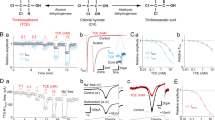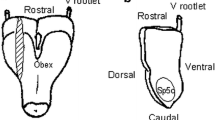Abstract
Although anticonvulsant drugs that block voltage-dependent Na+ channels have been widely used for neuropathic pain, including peripheral nerve injury-induced pain, much less is known about the actions of these drugs on immature trigeminal ganglion (TG) neurons. Here we report the effects of carbamazepine (CBZ) and amitriptyline (ATL) on tetrodotoxin-resistant (TTX-R) Na+ channels expressed on immature rat TG neurons. TTX-R Na+ currents (INa) were recorded in the presence of 300 nM TTX by use of a conventional whole-cell patch clamp method. Both CBZ and ATL inhibited TTX-R INa in a concentration-dependent manner, but ATL was more potent. While CBZ and ATL did not affect the overall voltage-activation relationship of TTX-R Na+ channels, both drugs shifted the voltage-activation relationship to the left, indicating that they inhibited TTX-R Na+ channels more efficiently at depolarized membrane potentials. ATL showed a profound use-dependent blockade of TTX-R INa, but CBZ had little effect. The present results suggest that both CBZ and ATL, common drugs used for treating neuropathic pain, efficiently inhibit TTX-R Na+ channels expressed on immature TG neurons, and that these drugs might be useful for the treatment of trigeminal nerve injury-induced neuropathic pain, as well as the inhibition of ongoing central sensitization, even during immature periods.
Similar content being viewed by others
References
Akaike, N. and Harata, N., Nystatin perforated patch recording and its application to analysis of intracellular mechanism. Jpn. J. Physiol., 44, 433–473 (1994).
Akopian, A. N., Souslova, V., England, S., Okuse, K., Ogata, N., Ure, J., Smith, A., Kerr, B. J., McMahon, S. B., Boyce, S., Hill, R., Stanfa, L. C., Dickenson, A. H., and Wood, J. N., The tetrodotoxin-resistant sodium channel SNS has a specialized function in pain pathways. Nat. Neurosci., 2, 541–548 (1999).
Amir, R., Michaelis, M., and Devor, M., Membrane potential oscillations in dorsal root ganglion neurons: role in normal electrogenesis and neuropathic pain. J. Neurosci., 19, 8589–8596 (1999).
Back, S. K., Kim, M. A., Kim, H. J., Yoon, Y., Hong, S. K., and Na, H. S., Neuropathic pain behaviors induced by peripheral nerve injury at neonatal rats. Soc. Neurosci. Abs., 31, No. 512.11. (2005).
Backonja, M. M., Use of anticonvulsants for treatment of neuropathic pain. Neurology, 59, S14–S17 (2002).
Baker, K. A., Taylor, J. W., and Lilly, G. E., Treatment of trigeminal neuralgia: use of baclofen in combination with carbamazepine. Clin. Pharm., 4, 93–96 (1985).
Bräu, M. E., Dreimann, M., Olschewski, A., Vogel, W., and Hempelmann, G., Effect of drugs used for neuropathic pain management on tetrodotoxin-resistant Na+ currents in rat sensory neurons. Anesthesiology, 94, 137–144 (2001).
Brock, J. A., McLachlan, E. M., and Belmonte, C., Tetrodotoxin-resistant impulses in single nociceptor nerve terminals in guinea-pig cornea. J. Physiol. (Lond.), 512, 211–217 (1998).
Campbell, J. N. and Meyer, R. A., Mechanisms of neuropathic pain, Neuron, 52, 77–92 (2005).
Davies, S. L., Loescher, A. R., Clayton, N. M., Bountra, C., Robinson, P. P., and Boissonade, F. M., Changes in sodium channel expression following trigeminal nerve injury. Exp. Neurol., 202, 207–216 (2006).
Elliott, A. A. and Elliott, J. R., Characterization of TTX-sensitive and TTX-resistant sodium currents in small cells from adult rat dorsal root ganglia. J. Physiol. (Lond.), 463, 39–56 (1993).
Kajander, K. C. and Bennett, G. J., Onset of a painful peripheral neuropathy in rat: a partial and differential deafferentation and spontaneous discharge in A beta and A delta primary afferent neurons. J. Neurophysiol., 68, 734–744 (1992).
LaMotte, R. H., Shain, C. N., Simone, D. A., and Tsai, E. F. P., Neurogenic hyperalgesia: Psychophysical studies of underlying mechanisms. J. Neurophysiol., 66, 190–211 (1991).
Lee, D. H. and Chung, J. M., Neuropathic pain in neonatal rats. Neurosci. Lett., 209, 140–142 (1996).
Leffler, A., Reiprich, A., Mohapatra, D. P., and Nau, C., Usedependent block by lidocaine but not amitriptyline is more pronounced in tetrodotoxin (TTX)-resistant Nav1.8 than in TTX-sensitive Na+ channels. J. Pharmacol. Exp. Ther., 320, 354–364 (2007).
Liu, B. and Eisenach, J. C., Hyperexcitability of axotomized and neighboring unaxotomized sensory neurons is reduced days after perineural clonidine at the site of injury. J. Neurophysiol., 94, 3159–3167 (2005).
Liu, C. N., Wall, P. D., Ben-Dor, E., Michaelis, M., Amir, R., and Devor, M., Tactile allodynia in the absence of C-fiber activation: altered firing properties of DRG neurons following spinal nerve injury. Pain, 85, 503–521 (2000).
Matzner, O. and Devor, M., Na+ conductance and the threshold for repetitive neuronal firing. Brain Res., 597, 92–98 (1992).
Matzner, O. and Devor, M., Hyperexcitability at sites of nerve injury depends on voltage-sensitive Na+ channels. J. Neurophysiol., 72, 349–359 (1994).
Novakovic, S. D., Tzoumaka, E., McGivern, J. G., Haraguchi, M., Sangameswaran, L., Gogas, K. R., Eglen, R. M., and Hunter, J. C., Distribution of the tetrodotoxin-resistant sodium channel PN3 in rat sensory neurons in normal and neuro-pathic conditions. J. Neurosci., 18, 2174–2187 (1998).
Rush, A. M. and Elliott, J. R., Phenytoin and carbamazepine: differential inhibition of sodium currents in small cells from adult rat dorsal root ganglia. Neurosci. Lett., 226, 95–98 (1997).
Schild, J. H. and Kunze, D. L., Experimental and modeling study of Na+ current heterogeneity in rat nodose neurons and its impact on neuronal discharge. J. Neurophysiol., 78, 3198–3209 (1997).
Sidebottom, A. and Maxwell, S., The medical and surgical management of trigeminal neuralgia, J. Clin. Pharm. Ther., 20, 31–35 (1995).
Tanelian, D. L. and Brose, W. G., Neuropathic pain can be relieved by drugs that are use-dependent sodium channel blockers: lidocaine, carbamazepine, and mexiletine. Anesthesiology, 74, 949–951 (1991).
Author information
Authors and Affiliations
Corresponding author
Rights and permissions
About this article
Cite this article
Hur, YK., Choi, IS., Cho, JH. et al. Effects of carbamazepine and amitriptyline on tetrodotoxin-resistant Na+ channels in immature rat trigeminal ganglion neurons. Arch. Pharm. Res. 31, 178–182 (2008). https://doi.org/10.1007/s12272-001-1138-x
Received:
Published:
Issue Date:
DOI: https://doi.org/10.1007/s12272-001-1138-x




